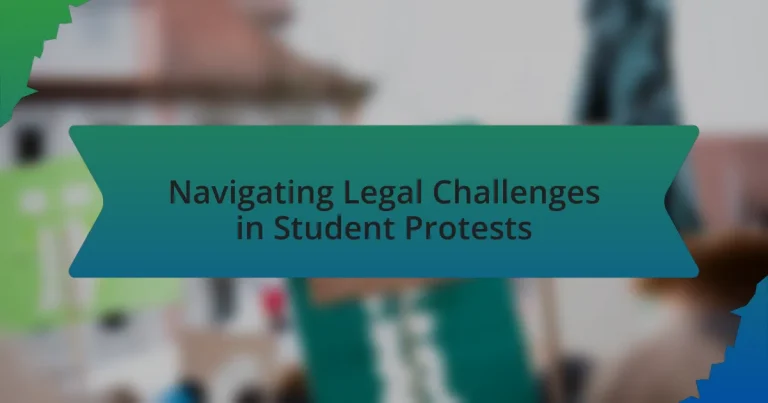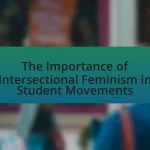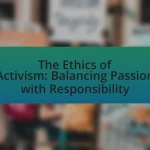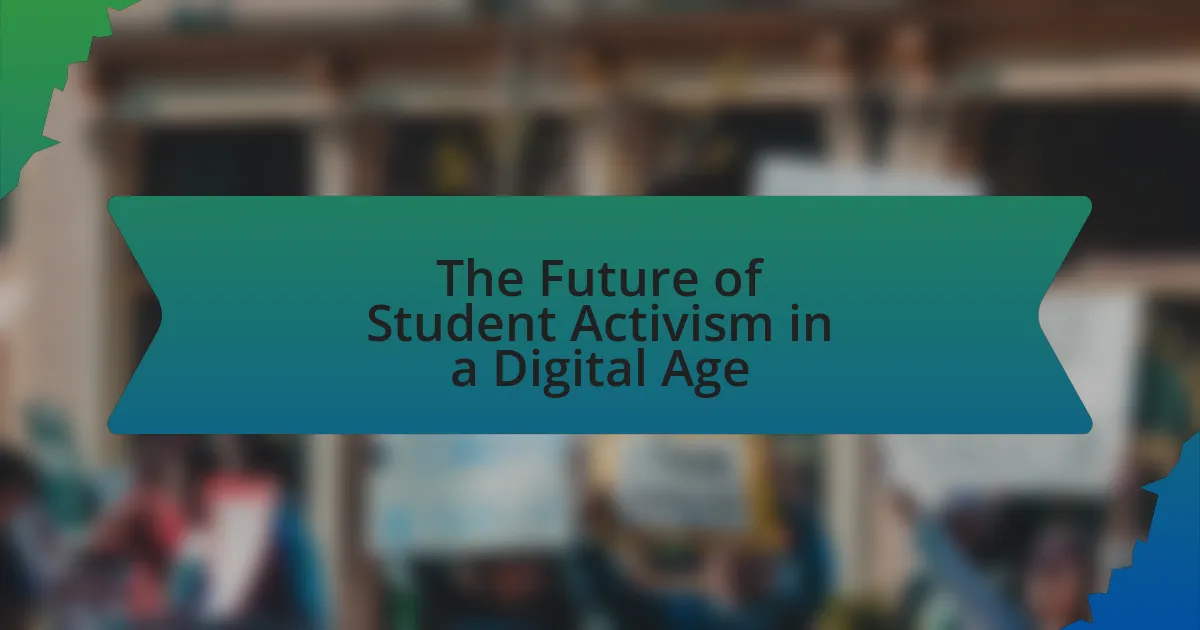The article focuses on the legal challenges faced during student protests, highlighting issues such as restrictions on freedom of assembly, potential criminal charges, and university policies that may limit protest activities. It examines how laws impact the organization of protests, the specific legal frameworks governing student activism, and the differences between local and federal regulations. The article also discusses the potential legal consequences for students, strategies for legal preparation, and the role of legal representation in influencing outcomes. Additionally, it addresses the implications of legal challenges on the effectiveness of student activism and offers best practices for minimizing legal risks while protesting.
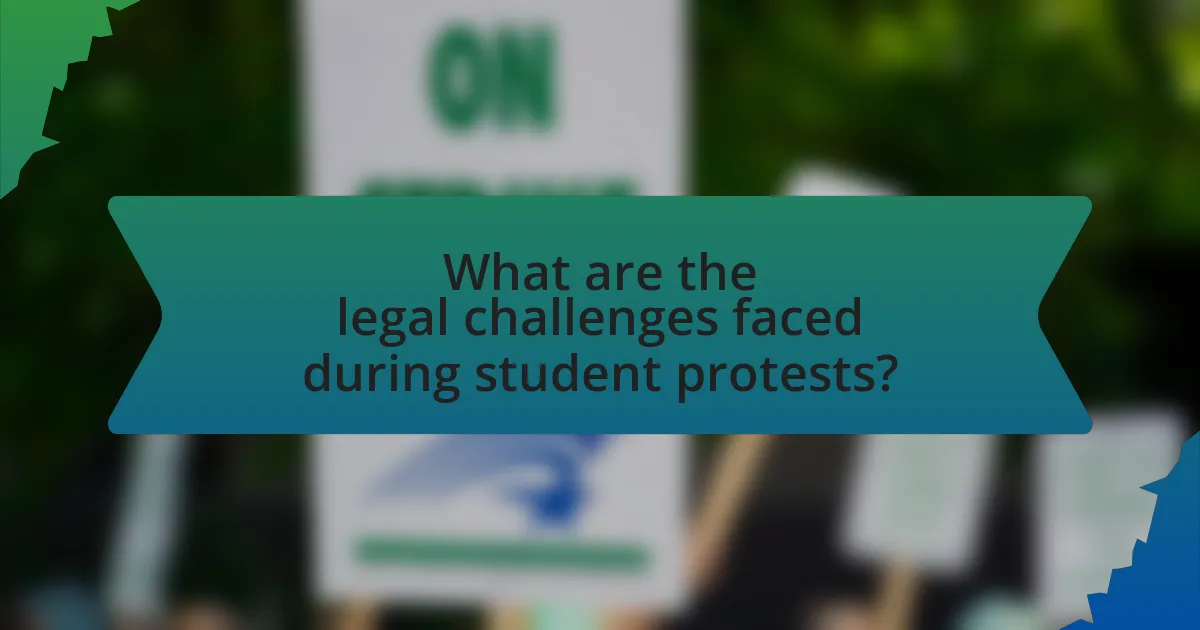
What are the legal challenges faced during student protests?
Student protests face several legal challenges, including restrictions on freedom of assembly, potential criminal charges for participants, and university policies that may limit protest activities. These challenges arise from laws that govern public gatherings, which often require permits and can impose penalties for unauthorized demonstrations. For instance, in the United States, the First Amendment protects the right to free speech and assembly, but local ordinances may restrict the time, place, and manner of protests. Additionally, students may encounter disciplinary actions from educational institutions, which can include suspension or expulsion for participating in protests deemed disruptive. These legal frameworks create a complex environment for student activism, where the balance between expression and regulation is often contested.
How do laws impact the organization of student protests?
Laws significantly impact the organization of student protests by establishing the legal framework within which these activities can occur. Regulations such as permitting requirements, restrictions on public spaces, and laws governing assembly dictate how and when students can gather to express their views. For instance, in the United States, the First Amendment protects the right to free speech and assembly, but local ordinances may require permits for protests, influencing the planning and execution of these events. Additionally, laws regarding noise levels, time restrictions, and the presence of law enforcement can affect the dynamics of student protests, shaping their scale and effectiveness.
What specific laws govern the right to protest in educational institutions?
The specific laws governing the right to protest in educational institutions primarily include the First Amendment of the U.S. Constitution, which protects freedom of speech and assembly. This constitutional right allows students to engage in protests as a form of expression, provided they do not disrupt the educational process. Additionally, various state laws and institutional policies may further define the parameters of protest, often requiring permits for organized demonstrations or setting guidelines for time, place, and manner restrictions. Courts have upheld these rights in cases such as Tinker v. Des Moines Independent Community School District, which affirmed that students do not “shed their constitutional rights to freedom of speech or expression at the schoolhouse gate.”
How do local and federal laws differ regarding student protests?
Local and federal laws differ in their approach to student protests primarily in terms of the scope of rights and regulations governing free speech and assembly. Federal laws, such as the First Amendment, protect the right to free speech and peaceful assembly across the United States, applying uniformly regardless of location. In contrast, local laws can vary significantly, as municipalities may impose specific regulations regarding the time, place, and manner of protests, which can include permit requirements or restrictions on noise levels. For instance, some local jurisdictions may require students to obtain permits for protests on school grounds, while federal protections do not impose such requirements. This discrepancy can lead to confusion for students navigating their rights, as local laws may impose additional limitations that federal laws do not.
What are the potential legal consequences for students participating in protests?
Students participating in protests may face legal consequences such as arrest, fines, or disciplinary actions from educational institutions. These consequences arise from laws governing public assembly, trespassing, or disorderly conduct, which can vary by jurisdiction. For instance, in the United States, students may be charged under local ordinances if protests disrupt public order or violate curfews. Additionally, schools may impose sanctions, including suspension or expulsion, based on their codes of conduct. Legal precedents, such as Tinker v. Des Moines Independent Community School District, affirm students’ rights to free speech but also highlight the limitations when such speech disrupts educational activities.
What charges can students face during protests?
Students can face various charges during protests, including disorderly conduct, trespassing, and resisting arrest. Disorderly conduct typically involves actions that disrupt public peace, such as loud or aggressive behavior. Trespassing charges may arise if students occupy private property without permission. Resisting arrest occurs when individuals attempt to evade law enforcement during an arrest. These charges are supported by legal precedents and statutes that govern public assembly and protest activities, highlighting the potential legal repercussions students may encounter while exercising their right to protest.
How can legal representation affect the outcomes for protesting students?
Legal representation significantly influences the outcomes for protesting students by providing them with essential legal guidance and advocacy. When students are represented by attorneys, they are better equipped to navigate the complexities of legal systems, which can lead to more favorable outcomes such as reduced charges, dismissal of cases, or successful defenses. For instance, a study by the National Lawyers Guild found that legal representation during protests can decrease the likelihood of arrests and enhance the protection of constitutional rights. Furthermore, attorneys can help ensure that students understand their rights and the legal implications of their actions, which can lead to more informed decision-making during protests.
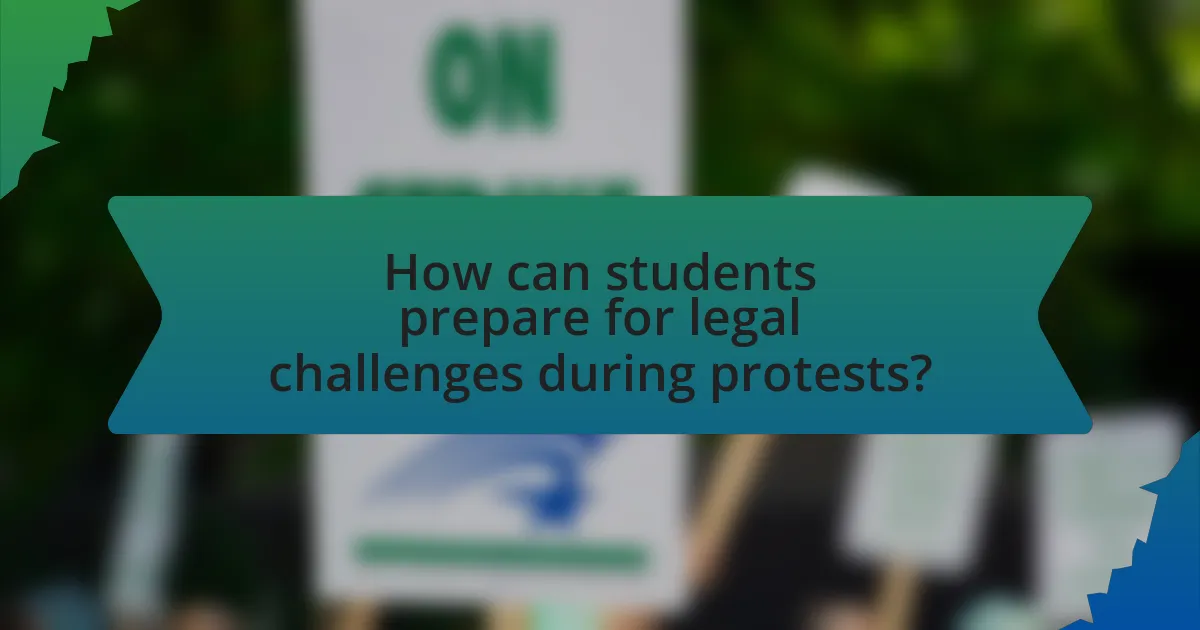
How can students prepare for legal challenges during protests?
Students can prepare for legal challenges during protests by understanding their rights, documenting events, and having legal support readily available. Familiarizing themselves with local laws regarding assembly and free speech is crucial, as these laws vary by jurisdiction and can impact the legality of their actions. Additionally, students should carry identification and know emergency contact information for legal aid organizations, which can provide assistance if they encounter legal issues. Documenting the protest through video or written accounts can serve as evidence if legal challenges arise, helping to establish the context and actions taken during the event.
What steps should students take before organizing a protest?
Students should conduct thorough research on local laws and regulations regarding protests before organizing one. Understanding the legal framework helps ensure compliance with permits, time restrictions, and designated protest areas. Additionally, students should gather support by engaging with fellow students and community members to build a coalition, which strengthens the protest’s impact. They should also create a clear message and objectives for the protest to communicate effectively with participants and the public. Finally, students must establish a safety plan, including identifying potential risks and coordinating with local authorities if necessary, to ensure the protest remains peaceful and organized.
How can students ensure compliance with local laws and regulations?
Students can ensure compliance with local laws and regulations by actively researching and understanding the specific legal frameworks that govern their activities. This involves reviewing local ordinances, university policies, and state laws relevant to protests and gatherings. For instance, students should familiarize themselves with laws regarding permits for public demonstrations, noise ordinances, and restrictions on the use of public spaces. Engaging with legal resources, such as campus legal aid services or local advocacy groups, can provide additional guidance. Furthermore, attending workshops or informational sessions on legal rights during protests can enhance their understanding and preparedness.
What resources are available for legal advice and support?
Legal advice and support for navigating challenges in student protests can be accessed through various resources. Organizations such as the American Civil Liberties Union (ACLU) provide legal assistance and guidance specifically for protest-related issues, including students’ rights. Additionally, university legal aid clinics often offer free or low-cost legal services to students facing legal challenges. Furthermore, local bar associations frequently have referral services that connect individuals with attorneys specializing in civil rights and protest law. These resources are validated by their established roles in protecting civil liberties and providing legal support to individuals in need.
What strategies can students use to protect themselves legally during protests?
Students can protect themselves legally during protests by understanding their rights, documenting events, and having legal support readily available. Knowing the First Amendment rights, which include freedom of speech and assembly, is crucial for students to assert their legal protections. Additionally, students should carry identification and avoid engaging in illegal activities, as these can lead to arrests. Documenting the protest through photos or videos can provide evidence in case of legal disputes, while having access to legal resources, such as a lawyer or legal aid hotline, ensures that students can receive immediate assistance if needed. These strategies are supported by various legal organizations that emphasize the importance of being informed and prepared during protests to mitigate legal risks.
How can students document their actions to safeguard against legal repercussions?
Students can document their actions to safeguard against legal repercussions by maintaining detailed records of their activities, including written accounts, photographs, and video recordings. This documentation serves as evidence of their intentions and actions during protests, which can be crucial in legal situations. For instance, keeping a journal that outlines the events, participants, and context of the protest can provide clarity and support their defense if legal issues arise. Additionally, collecting witness statements from fellow participants can further corroborate their accounts. Legal experts emphasize that thorough documentation can significantly impact the outcome of legal proceedings, as it helps establish a clear narrative and context surrounding the students’ actions.
What role do bystanders and legal observers play in protecting student rights?
Bystanders and legal observers play a crucial role in protecting student rights during protests by monitoring interactions between students and law enforcement. Their presence serves as a deterrent against potential abuses of power, ensuring that students can exercise their rights to free speech and assembly without fear of unlawful actions. Legal observers, often trained in civil rights law, document incidents and provide legal support, which can be vital in cases of police misconduct or violations of student rights. Research indicates that the presence of legal observers can lead to a decrease in arrests and injuries during protests, highlighting their effectiveness in safeguarding civil liberties.
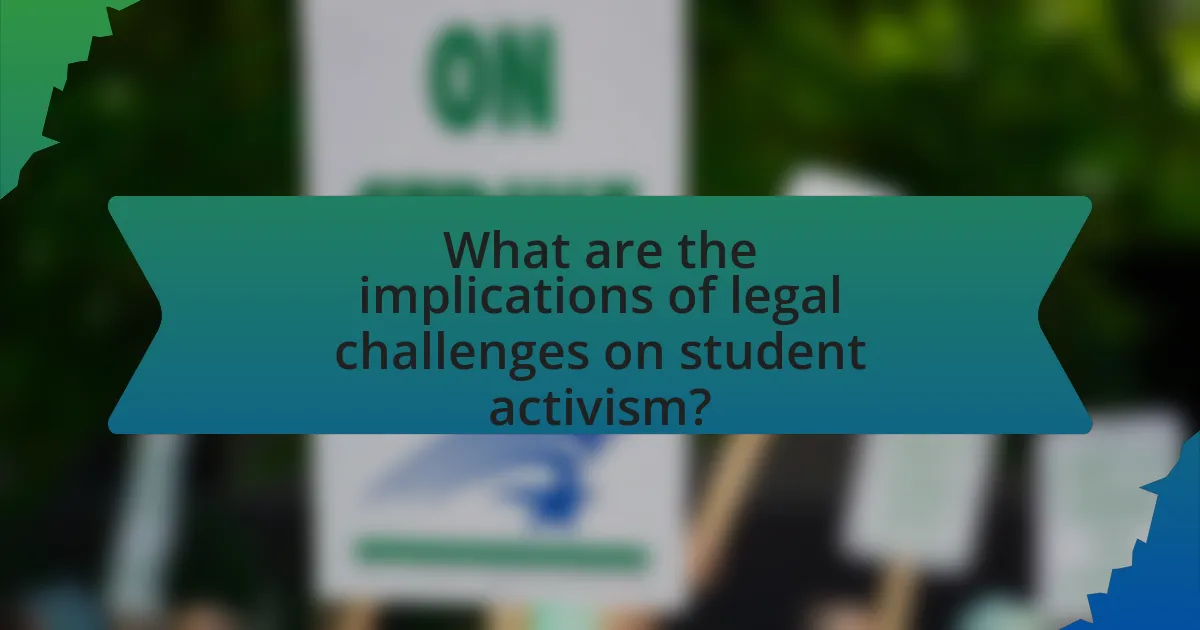
What are the implications of legal challenges on student activism?
Legal challenges significantly impact student activism by creating an environment of fear and uncertainty, which can deter participation in protests. When students face potential legal repercussions, such as arrests or disciplinary actions, they may choose to abstain from activism to avoid these consequences. For instance, the 2019 protests at the University of California, Berkeley, saw a decline in student participation after legal actions were taken against previous demonstrators, illustrating how legal repercussions can suppress activism. Additionally, legal challenges can lead to increased scrutiny and regulation of student organizations, further complicating their ability to mobilize effectively. This dynamic can stifle the voices of students and limit the scope of social movements on campuses.
How do legal challenges affect the effectiveness of student protests?
Legal challenges significantly hinder the effectiveness of student protests by imposing restrictions on their organization and execution. When legal actions, such as injunctions or arrests, are taken against student protesters, it can lead to decreased participation due to fear of repercussions. For instance, in 2011, the Occupy Wall Street movement faced numerous legal challenges that resulted in the dismantling of encampments, which diminished the movement’s visibility and momentum. Additionally, legal challenges can divert resources and attention away from the protest’s core message, as students may need to focus on legal defenses rather than advocacy. This combination of fear, reduced participation, and resource diversion ultimately undermines the overall impact of student protests.
What impact do legal repercussions have on future student activism?
Legal repercussions significantly deter future student activism by instilling fear of punitive measures among students. When students face potential legal consequences, such as arrests or disciplinary actions, they may become less willing to engage in protests or activism, fearing personal and academic repercussions. For instance, the 2011 Occupy Wall Street protests saw numerous arrests, which led to a chilling effect on subsequent student-led movements, as many students opted to avoid activism to protect their records and futures. This pattern indicates that the threat of legal action can suppress collective action and discourage participation in social movements, ultimately impacting the vibrancy and effectiveness of student activism.
How can student organizations adapt to navigate legal challenges?
Student organizations can adapt to navigate legal challenges by establishing clear guidelines and protocols for compliance with laws and regulations. This includes conducting regular training sessions on legal rights and responsibilities, which helps members understand the legal implications of their actions during protests. Additionally, organizations should collaborate with legal experts to develop a legal support network that can provide timely advice and representation if needed. Research indicates that organizations with proactive legal strategies are better equipped to handle disputes, as seen in the case of the University of California, where student groups successfully navigated legal challenges by implementing comprehensive legal training programs.
What lessons can be learned from past student protests regarding legal challenges?
Past student protests reveal that understanding legal frameworks is crucial for effective advocacy. For instance, the 1960s civil rights protests demonstrated the importance of knowing First Amendment rights, which protect freedom of speech and assembly. Additionally, the 2011 Occupy Wall Street movement highlighted the necessity of being aware of local laws regarding permits and public space usage, as many participants faced arrests due to violations. These historical examples underscore that students must educate themselves on legal rights and regulations to navigate potential legal challenges successfully.
What historical examples illustrate the legal challenges faced by student protesters?
Historical examples illustrating the legal challenges faced by student protesters include the 1964 Free Speech Movement at the University of California, Berkeley, where students faced arrests and university sanctions for advocating political activities on campus. Additionally, the Kent State University protests in 1970 resulted in the tragic shooting of four students by the National Guard, highlighting the severe legal and ethical implications of state responses to student dissent. Another significant case is the 2011 Occupy Wall Street movement, where student protesters encountered legal challenges such as eviction from public spaces and arrests for civil disobedience. These instances demonstrate the ongoing legal struggles that student activists face in exercising their rights to free speech and assembly.
How have legal outcomes shaped the landscape of student activism today?
Legal outcomes have significantly influenced the landscape of student activism today by establishing precedents that either empower or restrict students’ rights to protest. For instance, the Supreme Court’s ruling in Tinker v. Des Moines Independent Community School District (1969) affirmed students’ rights to free speech in schools, allowing them to engage in activism without fear of censorship, thus encouraging more organized and vocal movements. Conversely, recent legal decisions, such as those upholding restrictions on protests in certain public spaces, have created challenges for student activists, limiting their ability to mobilize effectively. These legal frameworks shape the strategies and methods students employ in activism, as they navigate the balance between exercising their rights and adhering to legal constraints.
What best practices can students follow to navigate legal challenges in protests?
Students can navigate legal challenges in protests by understanding their rights, organizing responsibly, and documenting events. Knowing First Amendment rights, including freedom of speech and assembly, is crucial for students to assert their legal protections during protests. Organizing protests in compliance with local laws, such as obtaining permits when necessary, helps mitigate legal risks. Additionally, documenting the protest through video and written accounts can provide evidence in case of legal disputes or police encounters. These practices are supported by various legal resources, including the American Civil Liberties Union, which emphasizes the importance of being informed about legal rights and responsibilities during public demonstrations.
How can students effectively communicate their rights during protests?
Students can effectively communicate their rights during protests by being informed about their legal protections and utilizing clear, concise messaging. Understanding the First Amendment rights, which include freedom of speech and assembly, allows students to articulate their rights confidently. Additionally, using visual aids like signs that state specific rights, such as “I have the right to protest,” can enhance visibility and clarity. Engaging with legal observers or organizations that specialize in civil rights can provide students with resources and support, ensuring they are aware of their rights and how to assert them during protests.
What are the key takeaways for students to minimize legal risks while protesting?
Students can minimize legal risks while protesting by understanding their rights, adhering to local laws, and planning their actions carefully. First, students should familiarize themselves with the First Amendment rights regarding free speech and assembly, which protect their ability to protest peacefully. Additionally, they must research local ordinances that may restrict certain types of protests, such as those requiring permits or prohibiting demonstrations in specific areas.
Moreover, students should consider organizing protests in designated public spaces where they are less likely to face legal repercussions. It is also advisable for students to document their actions and interactions with law enforcement, as this can provide evidence if legal issues arise. Lastly, having legal support or resources available, such as knowing how to contact legal aid organizations, can further protect students during protests.
